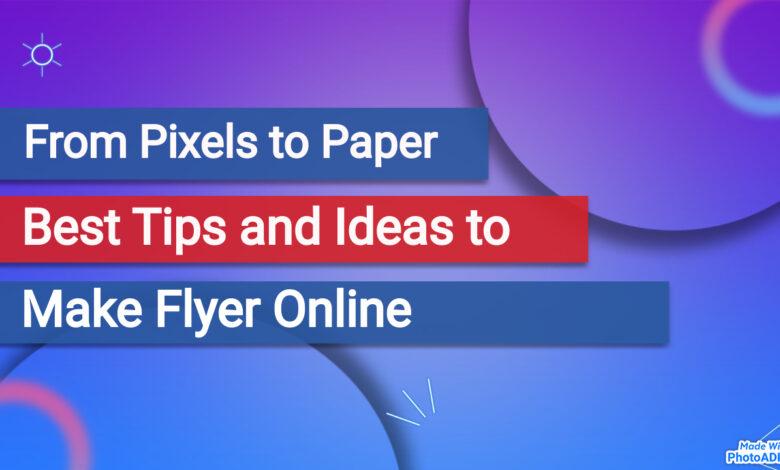From Pixels to Paper: Best Tips and Ideas to Make Flyer Online

In the digital age, where information travels at the speed of light, creating an impactful online flyer is a crucial aspect of any marketing strategy. Whether you’re promoting an event, product, or service, a well-designed flyer can make a significant difference. In this article, we’ll explore the best tips and ideas to make flyer online that not only catch the eye but also drive engagement.
Importance of Flyers in Marketing
The Tangible Impact
Flyers offer a tangible connection with your audience, leaving a lasting impression that digital ads often struggle to achieve. In this section, we explore why the physical presence of a flyer matters in a digital age.
The touch and feel of a well-designed flyer can evoke a sense of authenticity that is often lost in the digital realm. While online campaigns are essential, a strategically placed, visually appealing flyer can act as a tangible reminder of your brand or message.
Designing Your Flyer: Where to Begin
Understanding Your Audience
Before diving into the design process, it’s vital to understand your target audience. Uncover their preferences, tastes, and behaviors to tailor your flyer for maximum impact.
Whether you’re promoting an event, product, or service, knowing your audience allows you to create a flyer that resonates. Consider factors such as age group, interests, and the message you want to convey. This understanding forms the foundation for an effective and engaging flyer.
Choosing the Right Colors and Fonts
The Psychology of Design
The colors and fonts you choose for your flyer play a significant role in how it’s perceived. Understanding the psychology behind design elements can elevate your flyer’s visual appeal.
Colors evoke emotions and convey messages. For instance, warm colors like red and orange can create a sense of urgency, while cool colors like blue and green evoke calmness. Similarly, font styles contribute to the overall personality of your flyer. Experiment with different combinations to find the perfect match that aligns with your brand and message.
Crafting an Attention-Grabbing Headline
The Art of Verbal Hook
Your headline is the first impression your flyer makes. Learn how to craft attention-grabbing headlines that compel your audience to read further.
A compelling headline is concise, intriguing, and directly relates to the purpose of your flyer. Whether it’s a catchy slogan, a thought-provoking question, or a bold statement, make sure it piques interest and encourages the reader to explore more.
Engaging Imagery for Maximum Impact
A Picture’s Worth a Thousand Words
Visual elements are the backbone of a captivating flyer. In this section, we explore how to select and position images for maximum impact.
Images should not only be eye-catching but also relevant to your message. High-quality photos or graphics that align with your brand enhance the overall visual appeal. Consider the placement of images to guide the reader’s eye through the flyer, creating a seamless and enjoyable reading experience.
Including Essential Information
The Balance of Content
While brevity is key, essential information must not be overlooked. Find the right balance between concise content and necessary details to convey your message effectively.
Include crucial information such as event details, contact information, and a clear call to action. Use bullet points or short paragraphs to present information in a digestible format. Remember, clarity is paramount, and unnecessary clutter can detract from the flyer’s effectiveness.
Utilizing White Space Effectively
Simplicity Speaks Volumes
White space isn’t just space; it’s a design choice that enhances readability and visual appeal. Learn how to use white space effectively in your flyer.
Contrary to common belief, white space does not mean wasted space. It provides visual breathing room, allowing the reader to focus on the essential elements of your flyer. Experiment with layouts that balance content and white space to create a clean and organized design.
Call to Action: Guiding Your Audience
Directing Action
Every effective flyer needs a strong call to action. Explore strategies to guide your audience toward the desired action, whether it’s making a purchase or visiting your website.
The call to action should be clear, concise, and compelling. Use actionable language and create a sense of urgency when appropriate. Whether it’s a discount code, a limited-time offer, or an invitation to an event, your call to action should prompt immediate engagement.
Tools and Platforms for Online Flyer Creation
Navigating the Digital Landscape
Discover the myriad tools and platforms available for creating flyers online. From user-friendly apps to professional design software, find the right fit for your needs.
For those new to online flyer creation, user-friendly platforms like Canva and Adobe Spark provide intuitive interfaces and a range of templates. For more advanced designers, Adobe Creative Cloud offers a suite of professional tools for intricate and customized designs. Choose a platform that aligns with your skill level and design requirements.
Step-by-Step Guide to Creating a Flyer Online
A Practical Approach
Follow a step-by-step guide to creating a compelling flyer online. From layout to final touches, this section provides practical insights for beginners and seasoned designers alike.
Choose the Right Template: Select a template that suits your purpose. Whether it’s an event flyer, promotional flyer, or business flyer, starting with a template streamlines the design process.
Customize Colors and Fonts: Personalize the template by adjusting colors and fonts to match your brand or the theme of your message.
Add Engaging Content: Insert your headline, images, and essential information. Ensure a good balance between text and visuals for an aesthetically pleasing design.
Incorporate Call to Action: Place a clear and compelling call to action. Whether it’s a QR code, website link, or contact information, guide your audience on the next steps.
Review and Edit: Take a step back and review your design. Check for spelling errors, visual consistency, and overall coherence. Make necessary edits before finalizing.
Tips for Print-Friendly Flyers
Bridging the Gap
For those aiming to take their online creations into the physical realm, here are tips to ensure your flyer looks as good on paper as it does on the screen.
High-Resolution Images: Use high-resolution images to ensure clarity when printing. Low-quality images may appear pixelated in print.
CMYK Color Mode: Adjust your color settings to CMYK for print-friendly colors. This ensures that the colors appear as intended when printed.
Bleed and Margin Settings: Extend your design slightly beyond the edges to account for trimming variations. Additionally, set proper margins to avoid cutting off essential elements.
Choose the Right Paper: Consider the type of paper you’ll be using for printing. Glossy paper may enhance vibrant colors, while matte paper offers a more subtle finish.
Ensuring Mobile Responsiveness
Reaching a Mobile Audience
In an era dominated by mobile devices, your flyer must be mobile-friendly. Explore the importance of mobile responsiveness tips and Ideas to Make Flyer Online for achieving it.
Optimize your flyer for mobile viewing by choosing a responsive design template. Ensure that images and text scale appropriately on smaller screens. Test your flyer on various devices to guarantee a seamless experience for mobile users.
Tracking and Measuring Flyer Performance
Beyond Creation
The journey doesn’t end with the creation of your flyer. Learn how to track and measure its performance, allowing for insights and improvements in future campaigns.
Use Unique URLs or QR Codes: Include unique URLs or QR codes on your flyer to track online engagement. Monitor the visits or scans to gauge the flyer’s impact.
Analyze Online Analytics: Leverage online analytics tools to measure digital interactions. Track metrics such as click-through rates, time spent on the landing page, and conversion rates.
Collect Feedback: Encourage feedback through surveys or social media. Learn from your audience’s responses and use the insights to refine your future flyer campaigns.
Conclusion
In the exciting journey from pixels to paper, mastering the art of creating flyers online opens new avenues for effective marketing. By implementing the Tips and Ideas to Make Flyer Online discussed, you’re not just creating a flyer – you’re crafting a memorable experience for your audience.
Also Read: Display Boxes
FAQs
How can I make my flyer stand out among competitors?
To stand out, focus on a unique design, a compelling headline, and a clear call to action. Use vibrant colors and engaging imagery to capture attention.
Are there free tools for creating flyers online?
Yes, several free tools like Canva and Adobe Spark offer user-friendly interfaces for creating professional-looking flyers without a hefty price tag.
What information is essential to include in a flyer?
Ensure your flyer includes key details like event dates, contact information, and a brief, impactful message. Don’t overwhelm the reader with excessive information.
How can I measure the success of my flyer campaign?
Track metrics like engagement, click-through rates, and conversion rates. Utilize online analytics tools to gain insights into the performance of your flyer.
Is it necessary to optimize my flyer for mobile devices?
Absolutely. With a significant portion of users accessing content on mobile devices, ensuring your flyer is mobile-responsive is crucial for reaching a broader audience.
Also Read:- Evolution of Smartphones – Communication Tools to Multi-Purpose




